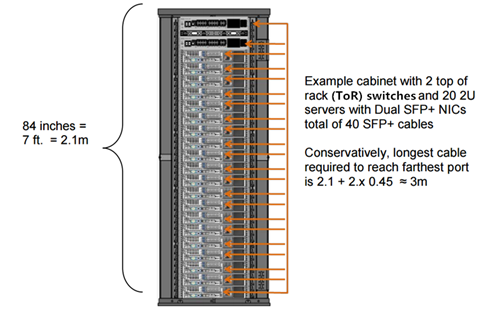Have you ever used the Cisco SFP+ twinax copper cable for connecting Cisco switches, as a cost-effective alternative to Cisco SFP+ transceivers for short-distance, high-speed connection? Or choosing other branded SFP+ twinax cables to connect their corresponding devices? In fact, SFP+ twinax cable becomes much more popular than ever before for its lower cost and easier installation than the SFP+ transceiver. You only need to incorporate the SFP+ twinax cables into the physical infrastructure directly, then the connection can be finished without any additional signal processing or conversion. However, although the SFP+ twinax cable is very easy to install, there are still two suggestions you should pay attention to if you choose it to deploy 10G short-distance connection.
Design the Length of the SFP+ Twinax Cables Your Network Needs
Before deploying your 10G short-distance connection, it is very important to design and calculate the length of the SFP+ twinax cables your network needs, avoiding many cables waste or lack of cables when deploying. How to calculate it? Just taking the single 84 in. 45 RU cabinet shown in the following figure as an example. As the cabinet is fitted with 2 top of rack switches and 20 2U servers with dual SFP+ NICs (Network Interface Cards), totally 40 SFP+ twinax cables are required. If you prepare to deploy SFP+ twinax cables in the cabinet, you should firstly calculate the longest connection from the top to the bottom of the cabinet, which is about 7 ft. or 2.1 m, and secondly the connection to any port on either end, approximately 1.5 ft. or 0.45 m. Then you can conclude that the longest cable required to reach the farthest port is 2.1+2×0.45≈3 m. Hence, the 3m SFP+ twinax cable should be long enough to connect any two ports within the cabinet.

Use Cable Management Tools to Support the SFP+ Twinax Cable
Since the bundled cable would be very heavy and tend to sag over time, the cable management tools like cable managers, strain relief bars and cable ties are the vital components to support the SFP+ twinax cables. Firstly, there is no doubt that the cable manager is designed for better cable management, as a very commonly used solution. And secondly, how about the strain relief bar? From its name, it is easy to learn that it is to support the cable by providing strain relief, which also facilitates the correct alignment of cable and connector into the port. Meanwhile, the strain relief bar also has the ability to keep the cables away from the spaces directly behind the server and switch equipment, reducing the thermal resistance through the equipment and promoting the effective cooling and airflow. Thirdly, cable ties should be used to hold the SFP+ twinax cables together and tie them to the strain relief bar and cable manager, although they looks so small and unimportant. What’s more, the cable tie installation should be done carefully to firmly place the cables, so that the cables will not move, and also not so tight as to deform or stress the cable jacket.
Conclusion
We all can’t deny that the SFP+ twinax cable provides an ideal low cost, low power and low latency solution for 10G short-distance connection deployment. In details, the cost of SFP+ twinax cable solution is up to three times less than that of fiber optical solution, the power it consumes is up to 50% less than that of current copper twisted-pair solution, and the latency is also lower than that of current copper twisted-pair solution. Furthermore, it features the smallest 10G form factor, as well as the overall cable diameter, designed for higher density and optimized rack space in 10G uplinks and 10G Fiber Channel SAN and NAS input/output connections. In short, the SFP+ twinax cable is an ideal solution to deploy 10G short-distance connection. If you are decide to deploy it, you are suggested to design and calculate the length of the SFP+ twinax cables your network needs and prepare the cable management tools to support the SFP+ twinax cables.
No comments:
Post a Comment